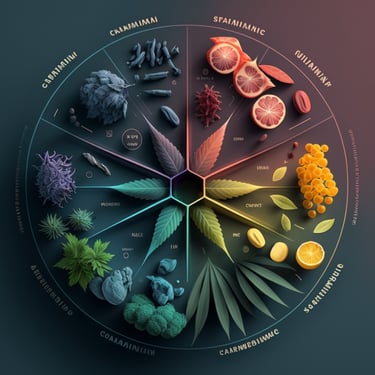The Entourage Effect and how Terpenes and Flavonoids contribute
The entourage effect is a term used to describe the synergistic relationship between the various compounds found in cannabis, including cannabinoids, terpenes, and flavonoids. The entourage effect suggests that the therapeutic effects of cannabis are greater when these compounds are taken together, rather than when they are taken individually.
The entourage effect is believed to occur because the various compounds found in cannabis interact with each other in complex ways. For example, some studies suggest that terpenes may enhance the absorption and bioavailability of cannabinoids by influencing the way that they are metabolized in the body. Other studies suggest that terpenes and flavonoids may work together to amplify the anti-inflammatory and analgesic effects of cannabinoids.
One of the most well-known examples of the entourage effect is the relationship between THC and CBD. While THC is the primary psychoactive compound in cannabis, CBD is non-psychoactive and is believed to modulate the effects of THC. Some studies suggest that CBD may counteract some of the negative side effects of THC, such as anxiety and paranoia, while enhancing its therapeutic effects, such as pain relief and appetite stimulation.
In addition to THC and CBD, many other cannabinoids have been shown to exhibit synergistic effects when taken together. For example, a study published in the Journal of Pain in 2010 found that a combination of THC and the cannabinoid cannabidiol (CBD) was more effective at reducing pain in patients with neuropathic pain than either compound taken alone.
Terpenes and flavonoids also play an important role in the entourage effect. For example, a study published in the British Journal of Pharmacology in 2011 found that the terpenes and phytocannabinoids found in cannabis may work together in what is known as the entourage effect, amplifying each other's therapeutic benefits. This suggests that terpenes and flavonoids may be an important component of the therapeutic effects of cannabis.
Some of the most well-known terpenes found in cannabis include myrcene, limonene, pinene, and linalool. Myrcene is believed to have anti-inflammatory, analgesic, and sedative effects, while limonene is believed to have anti-anxiety, anti-depressant, and anti-inflammatory effects. Pinene is believed to have anti-inflammatory, bronchodilator, and anti-cancer effects, while linalool is believed to have anti-anxiety, anti-inflammatory, and anti-depressant effects.
Flavonoids, such as quercetin and cannflavin A, have also been shown to exhibit significant therapeutic effects. Quercetin is believed to have anti-inflammatory, anti-viral, and anti-cancer effects, while cannflavin A is believed to have potent anti-inflammatory effects and is currently being investigated as a potential treatment for conditions like arthritis and other inflammatory disorders.
The entourage effect is a term used to describe the synergistic relationship between the various compounds found in cannabis, including cannabinoids, terpenes, and flavonoids. These compounds work together to produce the plant's therapeutic effects, which are believed to be greater when taken together rather than when taken individually. Terpenes and flavonoids play an important role in the entourage effect, enhancing the therapeutic benefits of cannabinoids and potentially offering new avenues for the development of effective treatments for a wide range of medical conditions.
Terpenes and flavonoids are compounds found in cannabis that have been the subject of increasing research interest in recent years. While much of the research has focused on the therapeutic potential of cannabinoids like THC and CBD, there is growing evidence to suggest that terpenes and flavonoids may also play an important role in the treatment of a wide range of medical conditions.
One of the most promising areas of research is the potential anti-inflammatory and analgesic effects of terpenes and flavonoids. Inflammation is a common underlying factor in many medical conditions, and compounds that can reduce inflammation may have therapeutic benefits for conditions such as arthritis, asthma, and inflammatory bowel disease.
Several terpenes have been shown to exhibit significant anti-inflammatory effects. For example, a study published in the Journal of Natural Products in 2013 found that the terpene beta-caryophyllene had potent anti-inflammatory effects in mice, potentially making it a promising treatment for conditions like arthritis. Another study published in the Journal of Ethnopharmacology in 2014 found that the terpene limonene had significant anti-inflammatory effects in rats.
Flavonoids have also been shown to have potent anti-inflammatory effects. A study published in the Journal of Natural Products in 2015 found that the flavonoid quercetin had significant anti-inflammatory effects in mice, potentially making it a promising treatment for conditions like asthma and allergic rhinitis. Another study published in the International Journal of Inflammation in 2016 found that the flavonoid apigenin had potent anti-inflammatory effects in mice.
Terpenes and flavonoids show promise in the treatment of anxiety and depression. While much of the research in this area has focused on the cannabinoid CBD, some studies suggest that terpenes may also have anti-anxiety and antidepressant effects.
A study published in the Journal of Ethnopharmacology in 2012 found that the terpene linalool had significant anti-anxiety effects in mice. Another study published in the Journal of Pharmaceutical Sciences in 2008 found that the terpene limonene had significant antidepressant effects in mice.
In addition to their potential anti-inflammatory and anti-anxiety effects, terpenes and flavonoids may also have potential in the treatment of conditions like cancer, epilepsy, and neurodegenerative disorders. While much more research is needed to fully understand their therapeutic potential, the growing body of evidence suggests that they may represent a promising new avenue for the development of effective treatments.
It's worth noting that the legal status of terpenes and flavonoids varies depending on the country and region in question. Some terpenes and flavonoids may be restricted or regulated, and patients considering the use of cannabis products for medical purposes should always consult with a healthcare professional and do their own research to ensure that they are making informed decisions.
Terpenes and flavonoids are compounds found in cannabis that have the potential to offer new avenues for the development of effective treatments for a wide range of medical conditions. While much more research is needed to fully understand their therapeutic potential, the growing body of evidence suggests that they may represent a promising new frontier in the field of medical cannabis.








